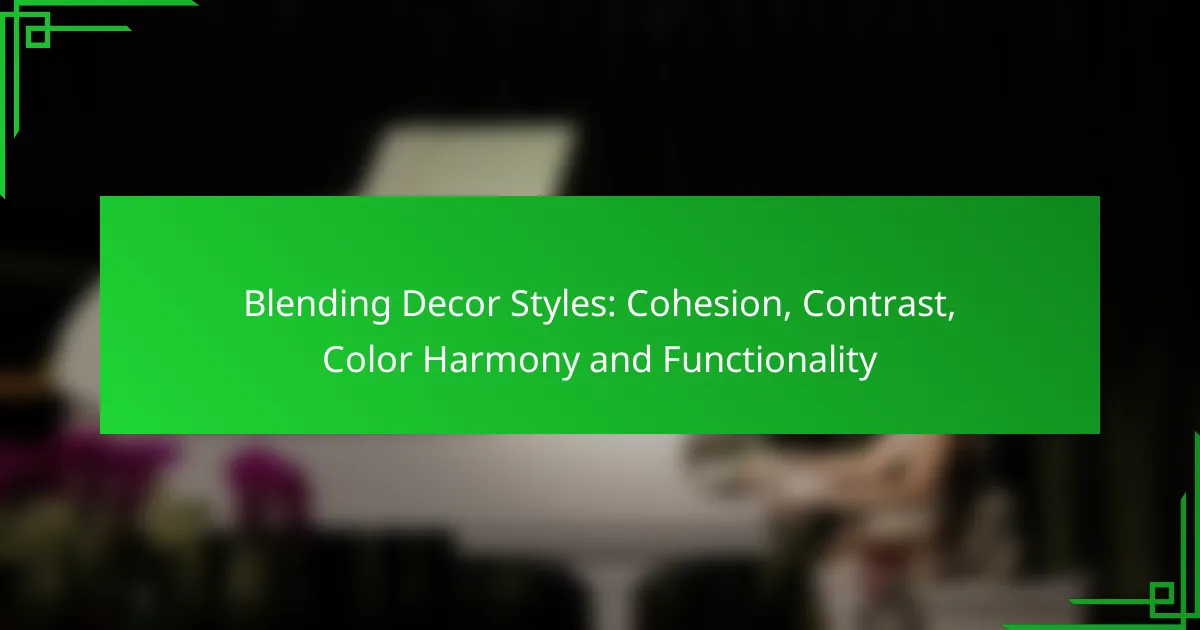Blending decor styles can transform a space into a cohesive yet dynamic environment, where various design elements work in harmony. By focusing on key aspects such as color, materials, and proportions, you can create a unified aesthetic while also incorporating effective contrast and color harmony to enhance visual interest. This thoughtful approach not only elevates the overall look but also ensures functionality within your decor.

How to blend decor styles for cohesion?
Blending decor styles for cohesion involves creating a harmonious environment where different design elements complement each other. Focus on key aspects like color, materials, and proportions to ensure a unified aesthetic throughout your space.
Use a unifying color palette
A cohesive color palette is essential for blending decor styles effectively. Choose a primary color that will serve as the foundation and select a few complementary shades to enhance the overall look. Aim for a palette that includes 3 to 5 colors to maintain balance without overwhelming the senses.
For example, if you prefer a modern and rustic mix, consider a base of warm neutrals with accents of deep greens or blues. This approach allows different styles to coexist while ensuring visual harmony.
Incorporate similar materials
Using similar materials across various decor styles can create a seamless transition between elements. Look for common materials such as wood, metal, or textiles that can be used in different forms throughout the space. This strategy helps to tie together disparate styles into a cohesive whole.
For instance, if you have a contemporary sofa, consider pairing it with a reclaimed wood coffee table and metal accents. This combination maintains a consistent feel while allowing for stylistic diversity.
Balance furniture scale and proportion
Maintaining balance in furniture scale and proportion is crucial when blending styles. Ensure that the size and shape of your furniture pieces complement each other to avoid a disjointed appearance. Large, bulky items can overwhelm smaller, delicate pieces, disrupting the overall flow.
A good rule of thumb is to mix furniture that shares similar heights or visual weights. For example, pair a low-profile sectional with a sleek, minimalist coffee table to create a balanced arrangement that feels intentional.
Choose complementary patterns
Selecting complementary patterns can enhance the visual interest of a blended decor style. Look for patterns that share a common color or theme, such as geometric shapes or floral designs, to create a cohesive look. Aim for a mix of textures and scales to add depth without clashing.
For example, if you have a bold striped rug, consider adding solid-colored cushions with subtle patterns that echo the rug’s colors. This approach ensures that patterns work together rather than compete for attention, resulting in a stylish and harmonious space.

What are effective contrast techniques in decor?
Effective contrast techniques in decor involve combining different styles, colors, and textures to create visual interest and harmony. By thoughtfully juxtaposing elements, you can enhance the overall aesthetic while maintaining a cohesive look.
Mix modern and vintage elements
Blending modern and vintage decor can create a unique and inviting atmosphere. Consider using contemporary furniture alongside antique accessories to establish a dynamic contrast. For instance, a sleek, minimalist sofa can be complemented by a vintage coffee table, creating a balanced yet eclectic space.
When mixing styles, aim for a common color palette to unify the elements. This approach helps to avoid a disjointed appearance while still allowing each piece to stand out. A good rule of thumb is to incorporate one or two vintage items for every modern piece to maintain a cohesive look.
Layer textures for depth
Layering different textures adds depth and interest to your decor. Combine smooth surfaces with rough materials, such as pairing a plush velvet throw with a woven jute rug. This contrast not only enhances the visual appeal but also invites tactile exploration.
To effectively layer textures, consider the scale and proportion of each element. For example, large, chunky knit blankets work well on a sleek sofa, while delicate lace curtains can soften the look of a sturdy wooden window frame. Aim for a mix of at least three textures to create a well-rounded and inviting space.
Utilize bold accent pieces
Bold accent pieces serve as focal points that draw attention and create contrast within a room. These can include vibrant artwork, oversized furniture, or striking light fixtures. For example, a bright red chair can stand out against a neutral backdrop, instantly elevating the space’s visual interest.
When selecting accent pieces, consider their scale and placement. Ensure they complement the overall decor without overwhelming the space. A good strategy is to choose one or two bold items per room, allowing them to shine while maintaining balance with subtler elements.

How to achieve color harmony in blended decor?
To achieve color harmony in blended decor, focus on creating a cohesive look by selecting a limited color palette that works well together. This involves understanding color relationships and how different shades can complement or contrast with one another.
Select a dominant color
Choosing a dominant color is crucial for establishing a foundation in your decor. This color should be present in larger areas, such as walls or major furniture pieces, to create a sense of unity. Aim for a color that resonates with the overall theme of your space, whether it’s warm, cool, or neutral.
For example, if you opt for a soft blue as your dominant color, you can use it on the walls and larger furniture items. This sets the tone and allows for other colors to play supporting roles without overwhelming the space.
Use analogous color schemes
Analogous color schemes involve selecting colors that are next to each other on the color wheel, creating a harmonious blend. This approach typically results in a serene and cohesive look, as these colors naturally complement each other. For instance, pairing blue with blue-green and green can create a tranquil atmosphere.
When using analogous colors, consider varying the shades and tints to add depth. For example, you might use a light blue for walls, a medium blue for upholstery, and a darker blue-green for accents. This layering enhances visual interest while maintaining harmony.
Incorporate neutral tones
Neutral tones serve as a balancing element in blended decor, allowing vibrant colors to stand out without clashing. Incorporating whites, grays, beiges, or browns can ground your color scheme and provide a backdrop that enhances other hues. Use these neutrals for larger surfaces like floors, ceilings, or major furniture pieces.
For effective use of neutrals, consider the overall warmth or coolness of your color palette. A warm beige can complement a palette of warm colors, while a cool gray might work better with cooler shades. This thoughtful integration helps maintain a cohesive and inviting space.

What functional considerations should be made?
When blending decor styles, it’s essential to consider functionality to ensure the space is both aesthetically pleasing and practical. Key factors include usability, traffic flow, and the incorporation of multifunctional furniture to maximize the efficiency of the area.
Assess space usability
Evaluating space usability involves understanding how the area will be used daily. Identify the primary activities that will take place and ensure the layout supports these functions. For example, a living room intended for relaxation and socializing should have comfortable seating arranged to facilitate conversation.
Consider the dimensions of the room and the placement of furniture to avoid overcrowding. Aim for a balance between style and practicality, ensuring that each piece serves a purpose while contributing to the overall aesthetic.
Consider traffic flow
Traffic flow is crucial in any space, as it affects how easily people can move around. Ensure that pathways are clear and that furniture placement does not obstruct movement. A good rule of thumb is to leave at least 60-90 cm of space for walkways, allowing for comfortable navigation.
When blending styles, be mindful of how different elements can influence flow. For instance, oversized furniture in a small room can create bottlenecks, while lighter, more streamlined pieces can enhance movement and openness.
Incorporate multifunctional furniture
Multifunctional furniture is a practical solution for maximizing space, especially in smaller areas. Look for pieces that can serve multiple purposes, such as a coffee table with storage or a sofa bed for accommodating guests. This approach not only saves space but also adds versatility to the decor.
When selecting multifunctional items, ensure they align with the overall design theme. For example, a sleek, modern ottoman can complement a contemporary style while providing additional seating and storage. Prioritize quality and durability to ensure these pieces withstand daily use.

What are common mistakes in blending decor styles?
Common mistakes in blending decor styles include overloading spaces with too many different styles, ignoring scale and proportion, and neglecting the effects of lighting. These pitfalls can lead to a chaotic and uninviting atmosphere, detracting from the intended aesthetic harmony.
Overloading with too many styles
One of the most frequent errors in blending decor styles is incorporating too many different themes or elements in a single space. This can create visual clutter and confusion, making it difficult for the eye to settle on any one feature. Aim to limit the number of styles to two or three that complement each other.
To achieve a cohesive look, select a unifying element, such as color or texture, that ties the different styles together. For instance, if combining modern and rustic elements, use a consistent color palette to bridge the gap between the two styles.
Ignoring scale and proportion
Ignoring scale and proportion can lead to a disjointed appearance in your decor. It’s essential to consider the size of furniture and decor items relative to the space they occupy. Large furniture in a small room can overwhelm the space, while tiny decor pieces in a large room may get lost.
A good rule of thumb is to choose furniture that occupies about two-thirds of the room’s scale. This helps maintain balance and ensures that each piece contributes to the overall harmony of the space.
Neglecting lighting effects
Lighting plays a crucial role in how decor styles are perceived and can significantly impact the overall ambiance. Neglecting to consider lighting can result in a space that feels either too harsh or too dim, which can distort the intended decor style. Natural light, ambient lighting, and accent lighting should all be thoughtfully integrated.
To enhance the blending of styles, use layered lighting techniques. For example, combine overhead fixtures with table lamps and wall sconces to create depth and warmth. This approach not only highlights different decor elements but also fosters a welcoming environment.

How to choose decor styles for specific rooms?
Choosing decor styles for specific rooms involves understanding the function of each space, the desired atmosphere, and how different styles can complement or contrast with one another. Consider the room’s purpose, the existing architecture, and your personal preferences to create a cohesive look.
Cohesion in Decor Styles
Cohesion in decor styles means creating a unified look throughout a space or home. To achieve this, select a primary style—such as modern, rustic, or industrial—and incorporate elements of that style consistently across different rooms. Use similar color palettes, materials, and textures to tie everything together.
For example, if you choose a modern style for your living room, consider using sleek furniture, neutral colors, and minimalistic decor in adjacent spaces like the dining room and hallway. This approach ensures that each room feels connected, enhancing the overall aesthetic.
Contrast in Decor Styles
Contrast in decor styles can add visual interest and depth to a space. This involves intentionally mixing different styles to create a dynamic environment. For instance, pairing vintage furniture with contemporary art can create a striking balance that showcases both elements.
When using contrast, ensure that the differences complement rather than clash. A good rule of thumb is to maintain a common color scheme or theme that runs through both styles, allowing them to coexist harmoniously. For example, a rustic wooden table can be paired with modern metal chairs in a dining area.
Color Harmony
Color harmony is essential when blending decor styles, as it helps unify different elements within a room. Start by selecting a base color that reflects your primary style, then choose accent colors that complement it. Aim for a balanced palette that includes a mix of neutrals and bolder shades to create visual appeal.
Consider using a color wheel to identify complementary colors or analogous shades that work well together. For instance, if your base color is a soft gray, you might add accents of navy blue and mustard yellow for a fresh, cohesive look.
Functionality
Functionality is a key consideration when choosing decor styles for specific rooms. Each space should serve its intended purpose effectively while also reflecting your personal style. For example, a home office should prioritize comfort and productivity, while a living room should foster relaxation and social interaction.
To ensure functionality, choose furniture and decor that fit the room’s size and layout. Avoid overcrowding spaces with too many decorative elements, as this can hinder usability. Instead, opt for multi-functional pieces, such as a coffee table with storage or a sofa bed, to maximize space and maintain style.
